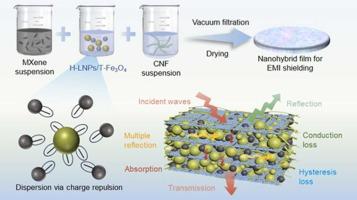Hyperbranched lignin nanoparticles-enabled nanohybrid film for high-performance electromagnetic interference shielding and dual-mode thermal management
IF 6.2
1区 农林科学
Q1 AGRICULTURAL ENGINEERING
引用次数: 0
Abstract
Electromagnetic interference (EMI) becomes a critical environmental and health concern with the proliferation of numerous electronic devices. However, achieving uniform dispersion and alignment of magnetic and conductive nanofillers to prepare EMI shielding films remains challenging. In this study, a bio-based multifunctional nanohybrid film, namely CNFs/MXene/T-Fe3O4/H-LNPs (CMFL), was constructed by integrating hyperbranched lignin nanoparticles (H-LNPs), cellulose nanofibrils (CNFs), MXene, and tetraethyl orthosilicate (TEOS) modified Fe3O4 (T-Fe3O4). It is hypothesized that the hydroxyl-rich H-LNPs, serving as effective dispersants, facilitate the uniform dispersion of T-Fe3O4 through electrostatic repulsion. Furthermore, these H-LNPs, acting as nano-bonding agents, not only promote the ordered alignment and interfacial bonding of MXene lamellae, but also endow the resultant CMFL film with excellent mechanical properties with tensile strength of 41.89 MPa. Thanks to the synergy of polarization, conduction, and hysteresis losses, the optimized CMFL film sample can achieve 61.3 dB of EMI shielding effectiveness at a thickness of 67 μm. Moreover, the nanohybrid film demonstrates dual-mode thermal management enhanced by photothermal conversion and Joule heating effects. It can rapidly heat to 76.1 °C under 1.0 kW·m−2 of solar irradiation and stabilize at 68.3 °C under a 3 V input. This study offers a sustainable approach to developing advanced bio-based materials for EMI shielding and thermal management applications.

用于高性能电磁干扰屏蔽和双模热管理的超支化木质素纳米颗粒纳米杂化膜
随着电子设备的激增,电磁干扰(EMI)成为一个严重的环境和健康问题。然而,实现磁性和导电纳米填料的均匀分散和排列以制备EMI屏蔽膜仍然具有挑战性。在本研究中,通过整合超支化木质素纳米颗粒(H-LNPs)、纤维素纳米纤维(CNFs)、MXene和正硅酸四乙酯(TEOS)修饰的Fe3O4 (T-Fe3O4),构建了一种生物基多功能纳米杂化膜CNFs/MXene/T-Fe3O4/H-LNPs (CMFL)。假设富羟基的H-LNPs作为有效的分散剂,通过静电斥力促进T-Fe3O4的均匀分散。此外,这些H-LNPs作为纳米键合剂,不仅促进了MXene片层的有序排列和界面键合,而且使制备的CMFL膜具有优异的力学性能,抗拉强度达到41.89 MPa。由于极化、传导和迟滞损耗的协同作用,优化后的CMFL膜样品在67 μm厚度下的电磁干扰屏蔽效能可达到61.3 dB。此外,纳米杂化膜表现出由光热转换和焦耳热效应增强的双模式热管理。在1.0 kW·m−2的太阳辐照下,它可以迅速加热到76.1℃,在3 V的输入下稳定在68.3℃。这项研究为开发用于电磁干扰屏蔽和热管理应用的先进生物基材料提供了一种可持续的方法。
本文章由计算机程序翻译,如有差异,请以英文原文为准。
求助全文
约1分钟内获得全文
求助全文
来源期刊

Industrial Crops and Products
农林科学-农业工程
CiteScore
9.50
自引率
8.50%
发文量
1518
审稿时长
43 days
期刊介绍:
Industrial Crops and Products is an International Journal publishing academic and industrial research on industrial (defined as non-food/non-feed) crops and products. Papers concern both crop-oriented and bio-based materials from crops-oriented research, and should be of interest to an international audience, hypothesis driven, and where comparisons are made statistics performed.
 求助内容:
求助内容: 应助结果提醒方式:
应助结果提醒方式:


